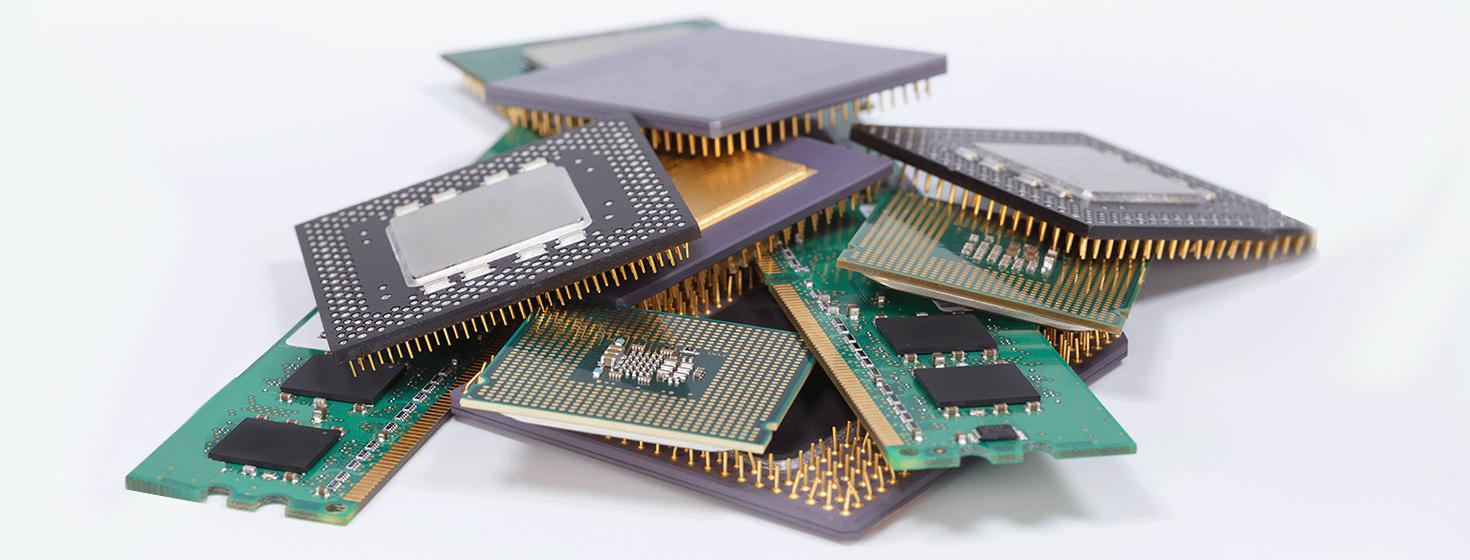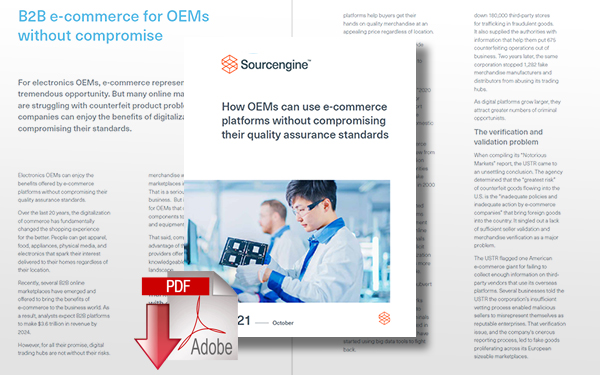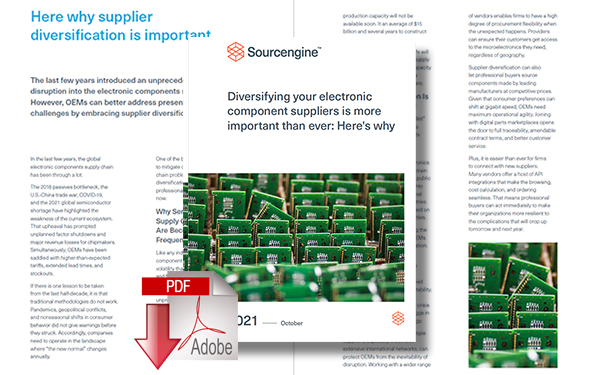Global Electronic Component Shortage - March Update

Several Japanese chipmakers halt production following an earthquake, Foxconn partially resumes production in Shenzhen, and DRAM prices to rise in Q2 2022.
Several Japanese Chipmakers Halt Production Following Earthquake
On March 16, a 7.4 magnitude earthquake struck Northeast Japan, causing two fatalities, over 100 injuries, and leaving thousands of people without water and power. The disaster also significantly disrupted the country’s manufacturers, including several chipmakers.
Renesas closed its Naka, Yonezawa, and Takasaki factories following the tremblor but partially reactivated the three sites on March 17. It reported no casualties or “significant facility damage” and said the Yonezawa plant would resume full production on March 20 while the Naka and Takasaki sites would restart on March 23. The vendor, like its contemporaries, has not disclosed the full impact of the event on its output.
Related Download: Sourcengine’s Semiconductor Industry Lead Time Report
DigiTimes noted the three fabs represent 40 percent of its overall capacity, and none of them produce auto chips.
Murata Manufacturing, a leading capacitor company, idled four factories after the earthquake struck and extinguished a fire at one facility. The firm has already restarted work at its Koriyama and Motomiya fabs and intends to bring its Tome and Sendai plants back to full utilization this week.
Sony paused operations at three domestic production complexes in the wake of the disaster. It plans to gradually resume work at its semiconductor laser, storage media, and image sensor production centers.
Kioxia shuttered its K1 Fab in Kitakami in the aftermath of the quake, pending an inspection. The plant is responsible for 8 percent of the manufacturer’s overall output. TrendForce reports the facility, which operates with Western Digital, sustained partial wafer input damage. The market intelligence provider expects the affected factory’s production yields will decrease in the first quarter due to tremblor.
Last month, Kioxia’s Kitakami and Yokkaichi sites experienced a contamination incident that significantly reduced its flash memory supply. DigiTimes expects the corporation’s 3D TLC NAND prices to rise by 15 percent and its MLC NAND bit rates by 5 percent soon.
Given the widespread nature of the disaster, other price changes and availability issues are likely coming soon.
Foxconn Partially Resumes Production in Shenzhen
Foxconn recently announced it partially resumed production in Shenzhen, China, under a “closed-loop management process” on March 16. The firm’s solution involves transporting tens of thousands of workers directly between its dormitories and factories and regular COVID-19 testing. Its insulated system had enabled it to restart operations even when the city of 17.5 million remained under lockdown.
The Chinese government introduced new policies to balance its approach to the coronavirus pandemic with regional economic concerns.
Chinese officials first enacted the “COVID zero” protocol to curb new nationwide infection rates shortly after the pandemic began. International health authorities applauded the strategy for strictly limiting illnesses and deaths in-country. However, widespread semiconductor production stoppages in the country’s industrial core played a big role in cultivating the global chip shortage.
Related: Nexperia’s NextPower MOSFETs offer best-in-class reliability and performance
Local leaders eventually lifted the lockdowns once the nation’s case numbers plummeted. But quarantine mandates returned earlier this month when the nation’s infection rates reached their highest levels in two years. Last Wednesday, Beijing allowed Foxconn to bring its second-largest manufacturing campus back online to mitigate lockdown-related financial fallout.
The government also lifted lockdowns on multiple areas in the Guangdong province because they reported no new COVID cases for several days. That said, China reported 4,100 new coronavirus infections last Thursday, with 105 coming from Shenzhen.
Consequently, the country’s latest COVID flareup, and its impact on many local chipmakers, is still an unfolding crisis.
DRAM Prices to Rise in Q2 2022
DRAM will become more expensive later this year due to the ongoing impact of the global chip shortage.
DigiTimes found spot DRAM prices have risen 5 to 7 percent in Q1 2022, while contract rates fell by 7 to 9 percent. However, the publication believes the component type will experience an across-the-board cost jump in the second quarter. It attributes the change to the priorities of the semiconductor industries memory chip manufacturers. At present, the field’s leading vendors are committed to refining their process technology to improve their yields.
But that means top DRAM manufacturers are directing funding away from production capacity expansion, limiting their output. Until the bottleneck within the segment is resolved, prices will probably continue climbing.
Previous Global Electronic Component Updates
Related Resources
Semiconductor Q1 2022 Lead Time Report
Sourcengine uses its robust market intelligence resources to create a thorough lead time report every quarter and features up-to-date availability information on a wide range of electronic components made by a slew of chipmakers including pricing and turnaround time forecasts through March 2022. Download Now!
9 Key Considerations When Shopping for Electronic Components Online
A comprehensive white paper exploring the key considerations that all procurement professionals should keep in mind when shopping for electronic components online. Download Now!
Why Chipmakers Cannot Quickly Fix the Global Semiconductor Shortage
In this white paper, we detail how large corporations and national governments are trying to resolve the global chip shortage, and how the complex nature of the semiconductor industry means there is no quick fix for the crisis. Download Now!
How OEMs Can Use Ecommerce Platforms without Compromising Their Quality Assurance Standards
In this white paper, we discuss why electronics OEMs, e-commerce represents have a tremendous opportunity, and why many online marketplaces are struggling with counterfeit product problems, however, companies can enjoy the benefits of digitalization without compromising their standards. Download Now!
Here’s Why Diversifying Your Electronic Component Suppliers is More Important Than Ever
This white paper details why the last few years introduced an unprecedented level of disruption into the electronic components supply chain, and how OEMs can better address present and future challenges by embracing supplier diversification. Download Now!
More Resources from Sourcengine
Related Article: Predictions for the 2022 Global Semiconductor Sector
Article Topics
Sourcengine News & Resources
The Impact of Inflation on the Electronics Components Supply Chain Industry How Rising Inflation is Disrupting the Electronics Components Supply Chain Semiconductor Q2 2022 Lead Time Report Global Electronic Component Shortage - May Update Semiconductor Q1 2022 Lead Time Report Global Electronic Component Shortage - March Update Predictions for the 2022 Global Semiconductor Sector More SourcengineLatest in Technology
Walmart’s Latest Service: Ultra Late-Night Delivery South Korea Finally Overtakes China in Goods Exported to U.S. SAP Unveils New AI-Driven Supply Chain Innovations U.S. Manufacturing is Growing but Employment Not Keeping Pace The Two Most Important Factors in Last-Mile Delivery Spotlight Startup: Cart.com is Reimagining Logistics Walmart and Swisslog Expand Partnership with New Texas Facility More Technology















